Each year, the New Zealand Book Awards for Children and Young Adults make for a massive occasion in the Aotearoa kids book world – move over Oscars, out of the way Silver Scrolls. This is our night. The awards celebrate excellence in writing, illustration and publishing – and they are a vital platform to recognise the most exciting and vibrant things happening in our part of the literary scene.
There are six main categories, with prize money of $7,500 to each winner. There’s also a Best First Book prize of $2,000, awarded at the judges’ discretion to a previously unpublished author or illustrator. The big moment of the night is the presentation of the Margaret Mahy Book of the Year Award, worth another $7,500, which is selected from the category winners.
As we’ve made it our NZCYA trademark, we have a bit of data crunching to kick things off and then a bit of commentary from all four Sapling editors, who have each taken on a category or two to consider. But we have made our picks for the win across all categories, because we can!
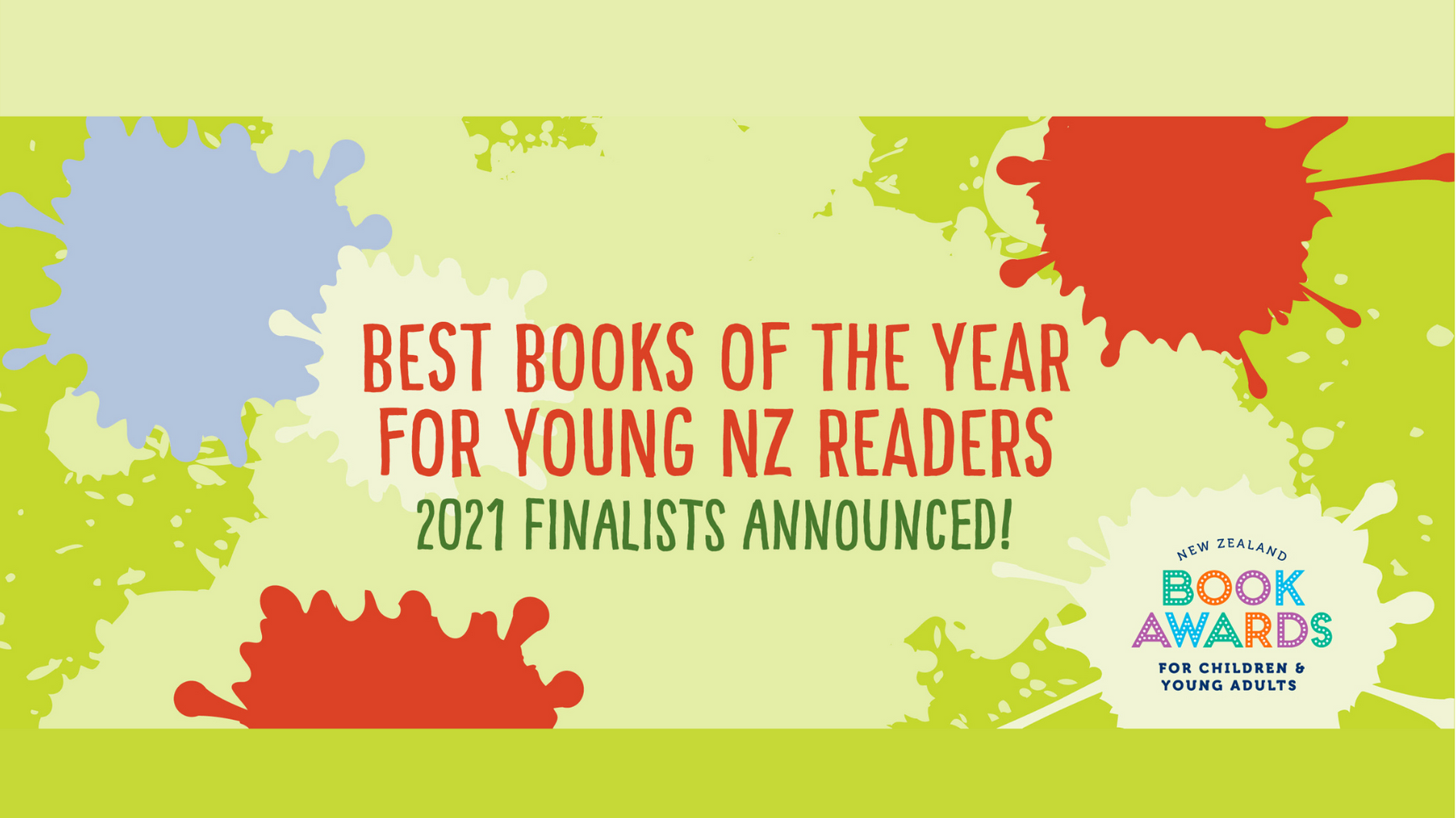
Crunching the numbers…
Ahh, I love the crunch of book-related numbers in the morning. It’s another potentially massive year for Huia, who could feasibly take home five different awards – or even six, if they also snagged the top gong AKA the Margaret Mahy Book of the Year.
Scholastic have the most titles up for prizes, with six books across four categories. We’re welcoming Lasavia and Write Laugh books to the finalist list for the first time, and we’re saluting a whole lot of other beloved stalwarts back with more bookish goodness year on year!
Here’s some good illustrator finalist fun facts:
- Three of the five finalists in the Russell Clark Illustration Award are in fact both illustrator and author of their finalist books. Creativity overfloweth.
- Four of the five Best First Book finalists are illustrators!
- The Te Kura Pounamu finalists all involve at least two creators – whether that’s author and illustrator, author-illustrator and translator or author, illustrator and translator. Except for Gavin Bishop! That clever clogs wrote Mihi’s simple Māori text himself and did the illustrations.
- For possibly the first time – at least as far as data detective Briar has sleuthed – all five finalists for the Russell Clark Illustration Award are women.
23 of the finalist slots are held by one or more women! The children’s book space continues to be female-dominated. Eight of the finalist slots are held by one or more men – and four of them are a combination.
16 finalist slots feature someone who has won an NZCYA Award before – and 13 finalist slots are occupied by first-time finalists. Bravo!
THE PICTURE BOOK AWARD FINALISTS
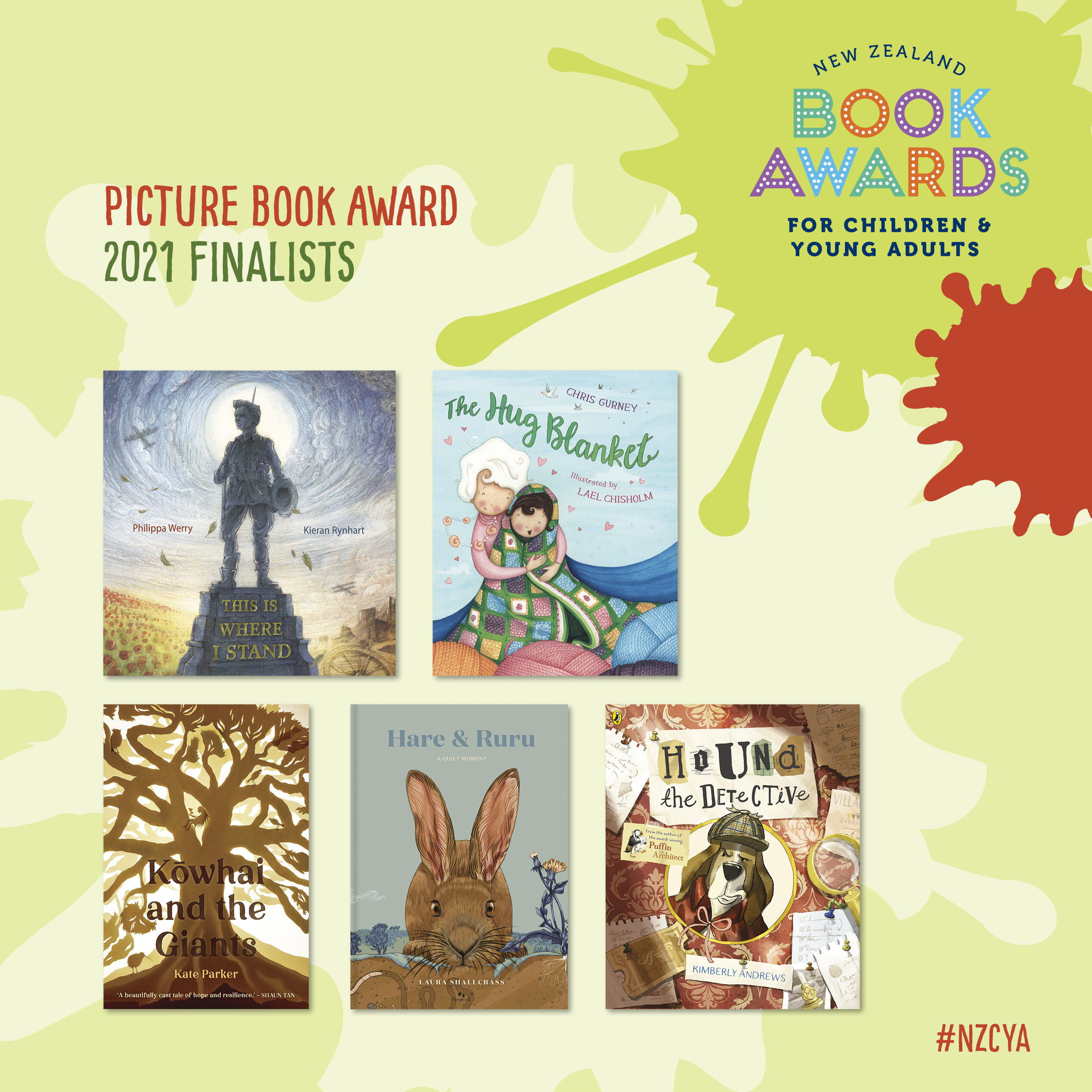
This is a fine line-up indeed. I love that all five are doing something a bit ‘tricky’! We have a beautiful sophisticated picture book with a historical bent, two very different but both gorgeous books that fit into what at least one bookshop euphemistically calls the ‘issues’ section, a stunning debut that plays with ecological themes and a vibrant and detail-packed search-and-find-skewed-story. There’s really something for everyone here, and I think that all five will be worthy additions to any home, school or library collection.
Historical picture books can be difficult to do well and compellingly, but Philippa Werry and Kieran Rynhart’s This is Where I Stand melds strong storytelling with evocative illustrations. It’s a new take on a wartime picture book that will be a valuable addition to the toolkit of any grown-up wanting to develop their ANZAC-oriented options.
Bereavement storytelling can be hard to handle in a new and useful way, but The Hug Blanket, written by Chris Gurney and illustrated by Lael Chisholm, brings bright colour and joyful memory to the dark times of grieving one’s beloved nana.
Books on anxiety or other mental health struggles can be dull and didactic, but Hare & Ruru by Laura Shallcrass is a thing of beauty both in illustration and simple yet effective character and plot development with two unlikely forest friends. A picture book that can make a class of fifteen-year-old kids gasp and ooh at the illustrations – as I discovered recently – is quite something.
Ecological underpinning in kids books can come across as very ‘worthy’ at the expense of good storytelling – but Kate Parker’s Kōwhai and the Giants manages to do its important and thoughtful storytelling while incorporating important themes and a luscious muted colour palette.
Books with a mystery to solve or a search and find to undertake sometimes do so at the expense of something glorious to look at. Not Kimberly Andrews’ Hound the Detective. Her super-detailed and super-stylish illustrations provide oodles of corners and crannies to hunt for clues without forgoing aesthetic joy. And the story’s a smash too.
Text by Briar Lawry
Our picks to win:
Briar: Hare & Ruru by Laura Shallcrass
Nida: Kōwhai and the Giants by Kate Parker
Sarah: This is Where I Stand by Philippa Werry and Kieran Rynhart
Simie: Kōwhai and the Giants by Kate Parker
The Wright Family Foundation Esther Glen Award for Junior Fiction Award Finalists
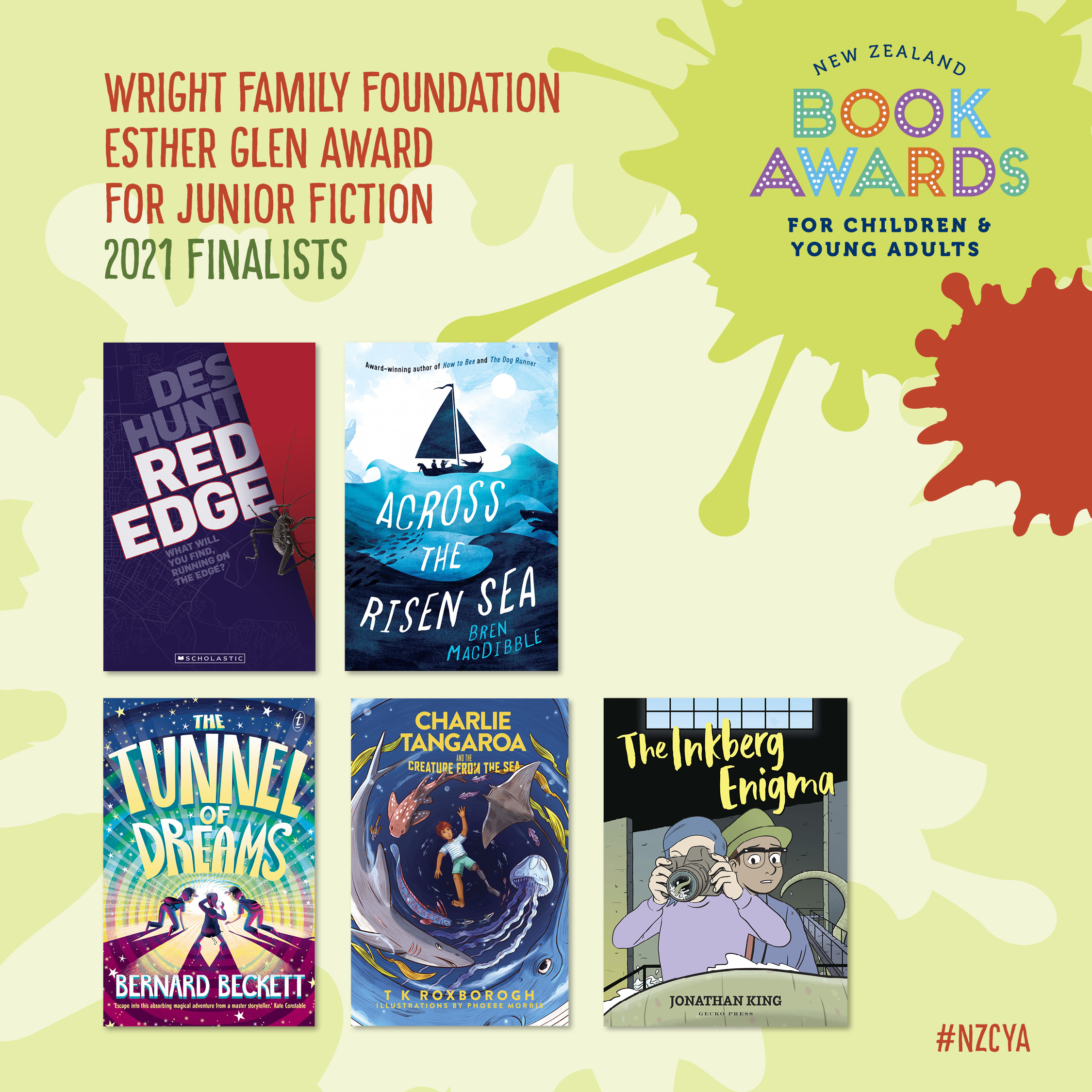
The Tunnel of Dreams, by Bernard Beckett
Identical twins Arlo and Stefan are drawn into an adventure in a parallel world, reached through a tunnel which only opens to identical twins. In this novel, Bernard Beckett explores Halfmen of O-like worlds of storytelling, with the alternate universe a tricksy place full of magic. Subterfuge, secrets, and plots abound in this ripper of a read, as Stefan joins a testing camp for elite magicians and learns to wield magic in a bid to save Alice’s twin sister. I think young readers will find this absorbing and compelling.
Across the Risen Sea, by Bren Macdibble
Neoma and Jaguar are best friends, living in Rusty Bus together in a village created by drastic climate change which saw the seas rise above most cities and towns. They scavenge to survive. Then one day, three People of the Sun come, cut trees, and build a tower with a red light on it, with mysterious power sources. When someone cuts it down, the People return and kidnap Jaguar, seeing Neoma off on a wild adventure. Bren’s magic is always her tone—she writes convincingly in the voice of a desperate 10-year-old on a big adventure. Highly enjoyable.
Charlie Tangaroa and the Creature from the sea, by T K Roxborogh
From the stunning cover, to the satisfying twist, everything about this book sings just as it ought to. Charlie Tangaroa only has one leg, but he is not going to let that stop him saving his part of Aotearoa. This book pits human technology against the Māori gods when Charlie and his brother save a ponaturi (mermaid), triggering the resumption of a grudge war between Tāne and Tangaroa. This is an assuredly good read from an expert writer who is enjoying exploring her culture.
The Inkberg Enigma, by Jonathan King
This category has been dominated by adventure books this year, to my delight. The Inkberg Enigma sees Miro and Zia discover their town of Aurora holds a dark secret under its waters, and set out to save the town from the tyranny of the monster in the deep. This graphic novel is King’s first, and sweeps you away with the assured skill of a master storyteller. While I don’t think this will beat Charlie in the junior fiction category, I can’t see how it would miss at Best First Book.
Des is a good writer, but he has missed the mark for me as far as taste goes in this book. Call me woke, but the subplot in this book involving an anorexic girl agreeing to eat more if her overweight neighbour eats less and exercises more is unrealistic at best. It’s a decent read set in red-zoned Christchurch, and deals with mental health delicately, but it’s not awards material for me.
Text by Sarah Forster
Our picks to win:
Briar: Charlie Tangaroa and the Creature of the Sea and Across the Risen Sea in an unprecedented tie, please.
Nida: Charlie Tangaroa and the Creature of the Sea for me.
Sarah: Charlie Tangaroa and the Creature from the Sea is my choice for winner here. I just feel like it edges out Across the Risen Sea – but it is a close race between these marine-themed titles!
Simie: Charlie Tangaroa and the Creature of the Sea and The Inkberg Enigma if Briar is heading into the dangerous waters of allowing a tie..
THE YOUNG ADULT FICTION AWARD finalists
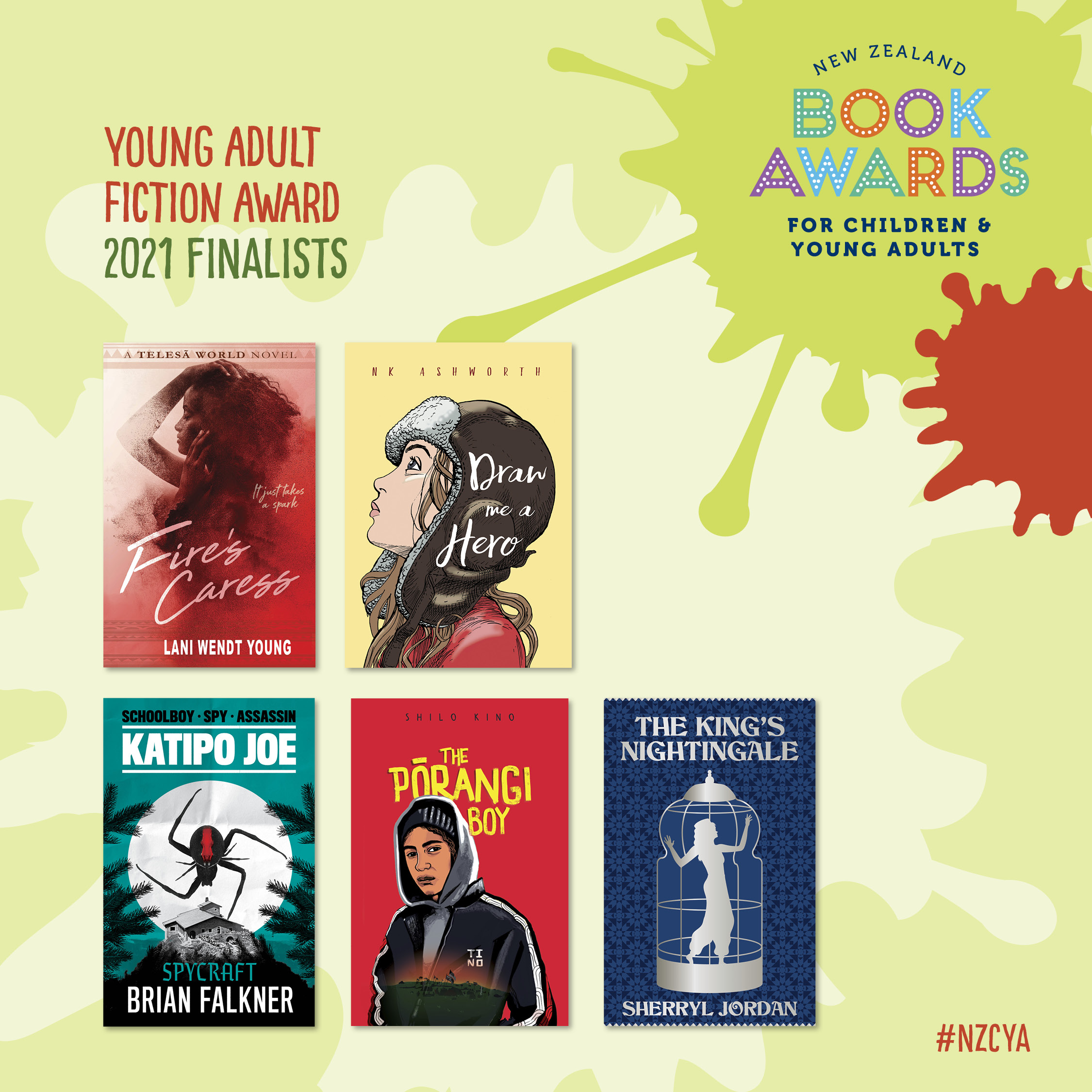
This is such a well-crafted story; it has oodles of heart and Shilo Kino has a way of holding the story paramount. Like his koro, Niko is called pōrangi and even more so when he opposes the plan to build a prison in Pohe Bay. Niko wants to protect their whenua and the taniwha, Tuakere who resides there. This has elements of a coming-of-age story, but it is so much more than that. The faultless dialogue provides seamless characterisation and brings to light the history and politics that sit at the core of this story. I hate picking a winner from a collection of such strong books, but this is the story that spoke to my heart and as such, would be my pick for the category winner
Draw Me a Hero by N K Ashworth
This is a short read, but woah, does it deal with a lot of issues. Jane lives with her mum and sister and loves to draw. When Bailey Summer moves into the house down the road, she reluctantly begins to collaborate on a graphic novel with him. Bailey’s history becomes intertwined with the story they create, and Jane needs to uncover the truth to help Bailey as he has helped her family. While the threads come together in this story a little too neatly at times, it is just so enjoyable. I can see why this made the grade! This is a well-deserved pick for this category from an author I am keen to see more of.
Fire’s Caress by Lani Wendt Young
When I think of the Telesā world that Lani Wendt Young has created I imagine her weaving many rugs with shared threads that are tightly woven throughout. I think I picture rugs because these books are just so comforting; you can wrap yourself in these stories and immerse yourself in the fantasy world she has created, and the world she creates has many threads that fit together so completely. Fire’s Caress focuses on the beautiful and talented sculptor, Teuila and the also very hot Keahi, who like Teuila, has magical powers. When Teuila is imprisoned by billionaire Marc Gold, things really start to heat up, in more ways than one. I am so pleased Fire’s Caress is a finalist, it is everything I wanted to read as a teen!
Katipō Joe #2: Spycraft by Brian Falkner
This sequel to Katipō Joe: Blitzkrieg, has all the elements that have come to feel very signature Brian Falkner to me – suspenseful, packed with adventure and well-honed storytelling. Set during World War II, Joseph St George is a teenager recruited by MI5. He sets out to infiltrate an elite Hitler Youth movement. Well-developed characterisation and the thought-provoking excerpts from Joe’s memoirs add depth that make this a solid pick for the finalists.
The King’s Nightingale by Sherryl Jordan
All the finalists are cracking storytellers and Sherryl Jordan is no exception. She has set the scene with rich characterisation and world building that firmly places you in the story. Elowen is the sort of strong female protagonist readers will love to love and cannot help but be captivated by. This is a story that focuses on a young white girl who is sold as a slave, as she has a beautiful voice, she becomes the ‘King’s nightingale’. Telling the story from the perspective of a white slave felt a bit of an odd choice to me, but there is no doubting the skill with which this story is told.
Text by Simie Simpson
Our picks to win:
Simie: The Pōrangi Boy by Shilo Kino
Briar: Fire’s Caress by Lani Wendt Young
Nida: The Pōrangi Boy by Shilo Kino
Sarah: The King’s Nightingale by Sherryl Jordan
THE ELSIE LOCKE AWARD FOR NON-FICTION FINALISTS
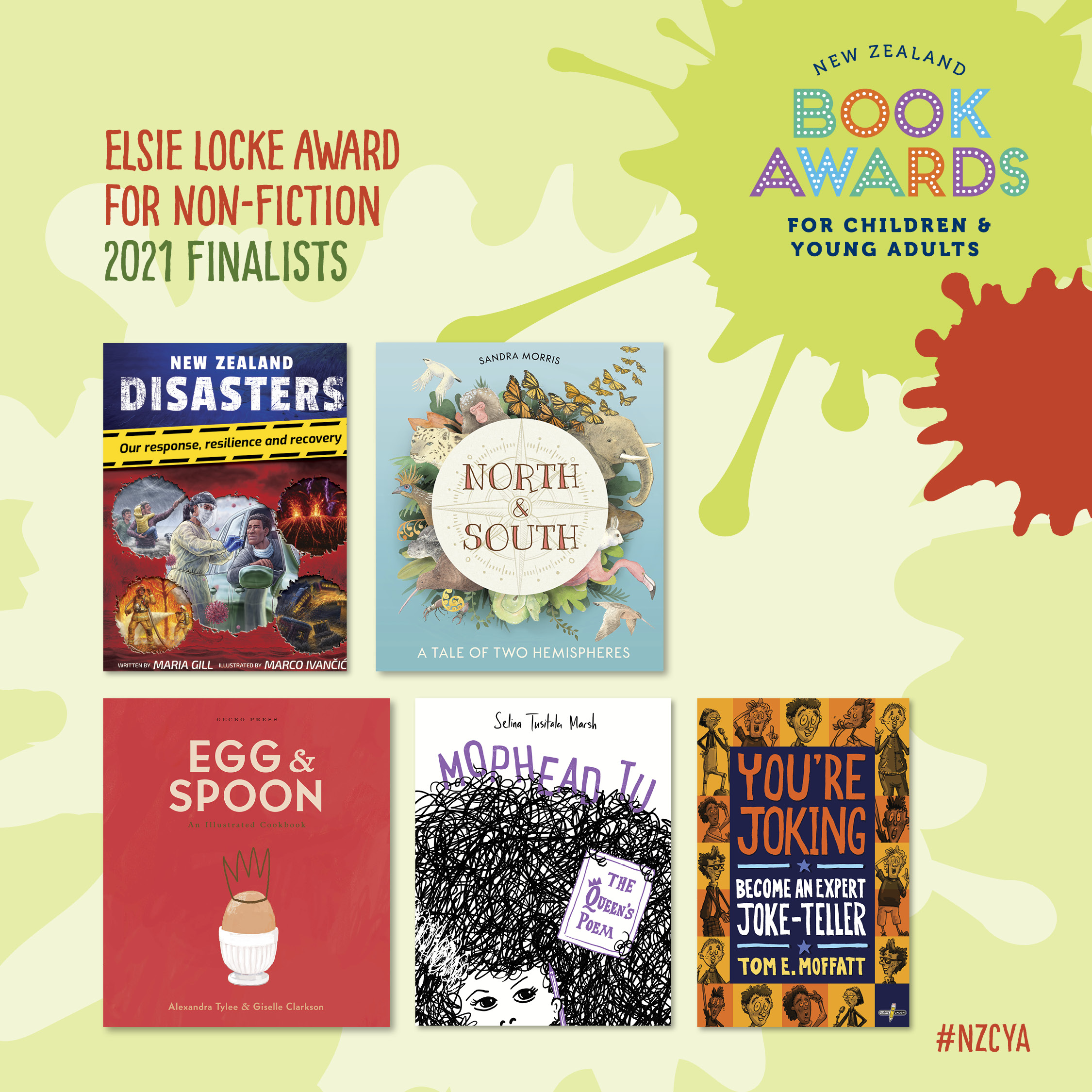
New Zealand Disasters, by Maria Gill and Marco Ivančić
Maria Gill’s incredibly well researched (and up-to-date!) addition to NZ’s disaster book category makes for a brilliant teaching resource and excellent reading material for young kids with an interest in the topic or a passion for history. It covers all the natural/human disasters that have occurred in the country in the past 200 years in a clear and succinct way, with infographics, maps and photographs that serve as great visual aids. But what makes this book a really great choice is it’s positive outlook: it focuses more on people’s responses, resilience and recovery rather than the gore, grief and trauma often associated with disasters. A necessity I reckon, after the past two years we’ve had.
North and South, by Sandra Morris
Born out of climate change concerns, Sandra’s latest non-fiction book looks at Earth’s hemispheres, seasons, animals, and how they’re being affected by rising temperatures and sea levels. It’s jam-packed with fun facts about the animals, mini maps to show their locations and conservation status’, and tips for how readers can help. It’s a great one to read from start to finish, or to open up at any random point and dive right in. The design of the book is spectacular and Sandra’s watercolour illustrations are as beautiful as ever (not to mention catered to the little ones by taking up most of the double page spreads). A marvelous addition to any home library, and another fantastic teaching resource.
Egg and Spoon: An Illustrated Cookbook, by Alexandra Tylee and Giselle Clarkson
This delectable collection of simple and adventurous recipes will have both the young’uns and the adults stoked to be in the kitchen. Our resident illustrator extraordinaire, Giselle is responsible for the scrumptiously whimsical depictions of food in this cookbook (many of which give me major Quentin Blake vibes!), and chef Alexandra comes through with the magical, joyful and carefree words. It’s a must-have in everyone’s kitchen, especially since there’s so many easy swaps to cater to all sorts of dietary requirements/allergies.
Mophead Tu: The Queen’s Poem, by Selina Tusitala Marsh
Selina’s Mophead was a big winner last year, and I have no doubt in my mind that it’s sequel will be a winner this year too. Mophead Tu is just as bold, clever, and charming as its predecessor was, tackling big topics such as colonialism and its consequences in an easily digestible, and equally humorous way. This time, Selina looks at what it means to be true to herself, her ancestors, and her morals, as she writes and performs a poem for the queen. Her illustrations are as fabulous as ever and the purple accent colour in this book was an awesome touch (and a clever nod to royal storyline).
You’re Joking: Become an Expert Joke-Teller, by Tom E. Moffat and Paul Beavis
As a former bad joke-teller, Tom has come out with a banger of an instruction manual featuring 101 jokes, to help people both young and old to develop their joke telling skills – something he claims, “can be mastered with practice”. This is an adorable resource for anyone struggling to be funny. Tom provides useful tips, exercises, and multiple examples to illustrate his points. I really loved the fact that Tom was speaking from experience, and that the text was in second-person. It really feels like he’s speaking to the reader and that he understands their struggles which in turn makes them trust what he has to say.
Text by Nida Fiazi.
Our picks to win:
Briar: Mophead Tu by Selina Tusitala Marsh
Nida: Mophead Tu by Selina Tusitala Marsh
Sarah: Mophead Tu by Selina Tusitala Marsh
Simie: Mophead Tu by Selina Tusitala Marsh
The Russell Clark Award for Illustration Finalists
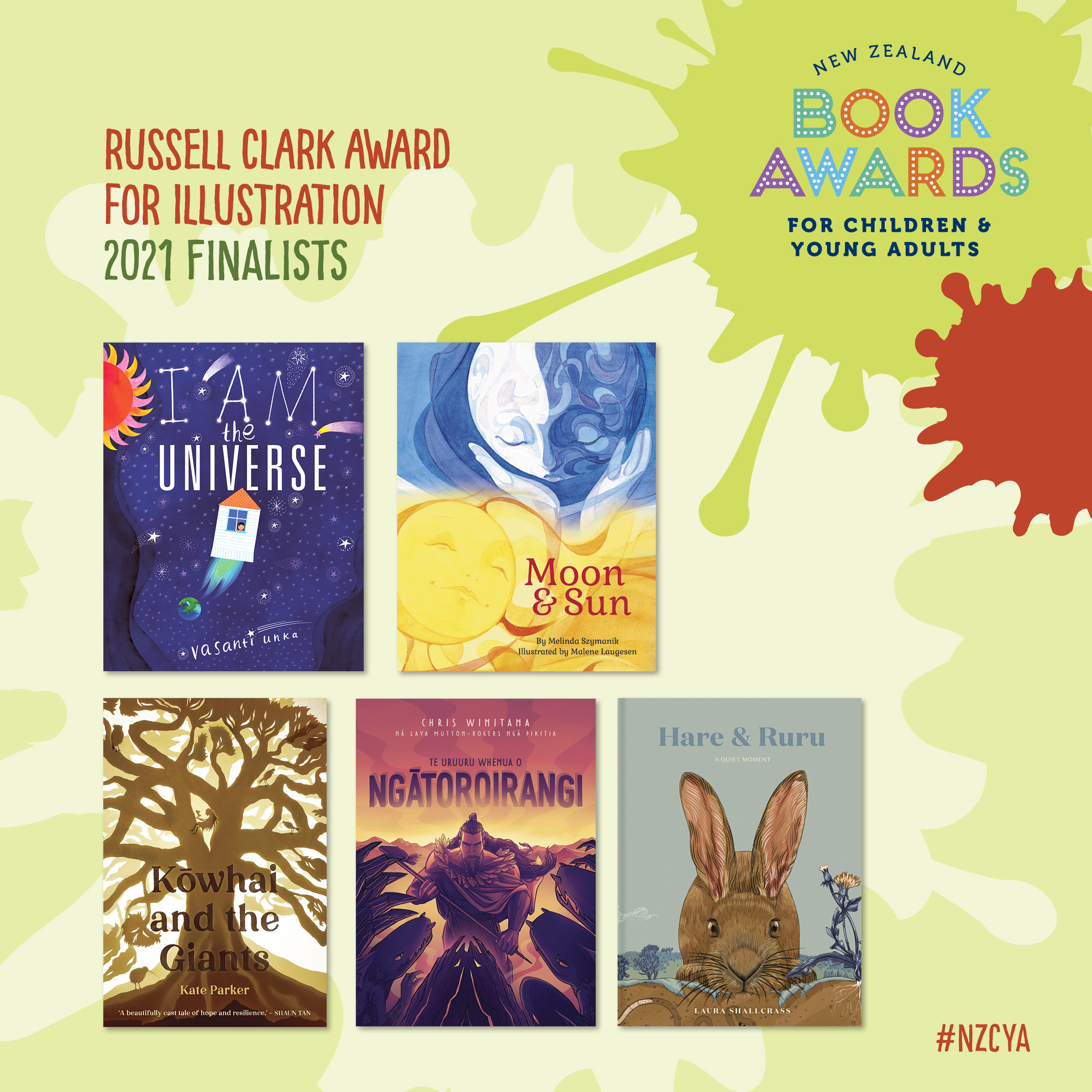
I Am the Universe, by Vasanti Unka
The first few pages of this beautiful hardback book feels like looking into a kaleidoscope; there’s so much to feast your eyes upon! Each and every spread is incredibly detailed and bursting with a medley of colours and patterns. I love the way Vasanti has seamlessly blended facts that don’t work as well in the main text with the illustrations, and I couldn’t help the smile that spread across my face when I spotted a hijabi in the city spread. Small as the drawing may have been, nothing can compare to the feeling of being seen. An experience many can look forward to with this book!
Moon & Sun, by Melinda Szymanik and Malene Laugesen
This is a story of comparison and self-worth that will resonate with just about everyone. Malene’s signature dreamy illustrations, and the watercolour medium she employs, evoke a real sense of movement and fluidity – an accurate portrayal of the growth and change in perspective that Moon experiences as the tale progresses. The largely blue and yellow colour palette is effective in characterising the two siblings: Sun with her warm, bright and shining light, and Moon with her cool aura and darker moods. Malene does a superb job of depicting emotion, particularly melancholy, and towards the end, the peace and contentedness that Moon feels when she realises the value of her individuality.
Kōwhai and the Giants, by Kate Parker
Kate’s first (can you believe it?!) book is a stunning work of art. Hand-cut paper, expertly placed and positioned in plywood boxes, then lit up from behind and photographed create a muted and cohesive colour-palette to compliment Kate’s poetic storytelling. What a beautiful way to get tamariki interested in taking care of our environment (specifically tree conservation) and saving the planet (as Kate puts it) “one seedling at a time”.
Te Uruuru Whenua o Ngātoroirangi, by Chris Winitana and Laya Mutton-Rogers
Despite not being able to understand the text (told in te reo Māori), I was able to follow the story, and more importantly, feel it – all thanks to Laya’s striking ability to capture emotion, action and movement within her illustrations. Her line work, rich colour palette consisting of practically every colour of the rainbow, use of space, and the minute details she adds into each spread do as much of the storytelling as the text, and make the adventures and journey of Ngātoroirangi accessible to all, regardless of their te reo skills.
Hare & Ruru: a quiet moment by Laura Shallcrass
This is an easy, gentle, and absolutely gorgeous read about learning to manage loud thoughts and feelings, or as Hare puts it “noise”. Laura’s illustrations are beyond lush. The earth-toned colour palette and dedication to depicting the natural environment (especially the focus on what’s under the soil, like shells and rocks) feel very grounding. There’s also a wonderful balance of very pared back, simple spreads and more intricate and busy spreads throughout the whole book which leave you feeling mindful of your surroundings, and at peace by the time you’ve reached the end.
Text by Nida Fiazi.
Our picks to win:
Briar: Hare & Ruru by Laura Shallcrass
Nida: Te Uruuru Whenua o Ngātoroirangi illustrated by Laya Mutton-Rogers
Sarah: I Am the Universe by Vasanti Unka
Simie: Te Uruuru Whenua o Ngātoroirangi illustrated by Laya Mutton-Rogers
The Wright Family Foundation Te Kura Pounamu Award for te reo MAAori
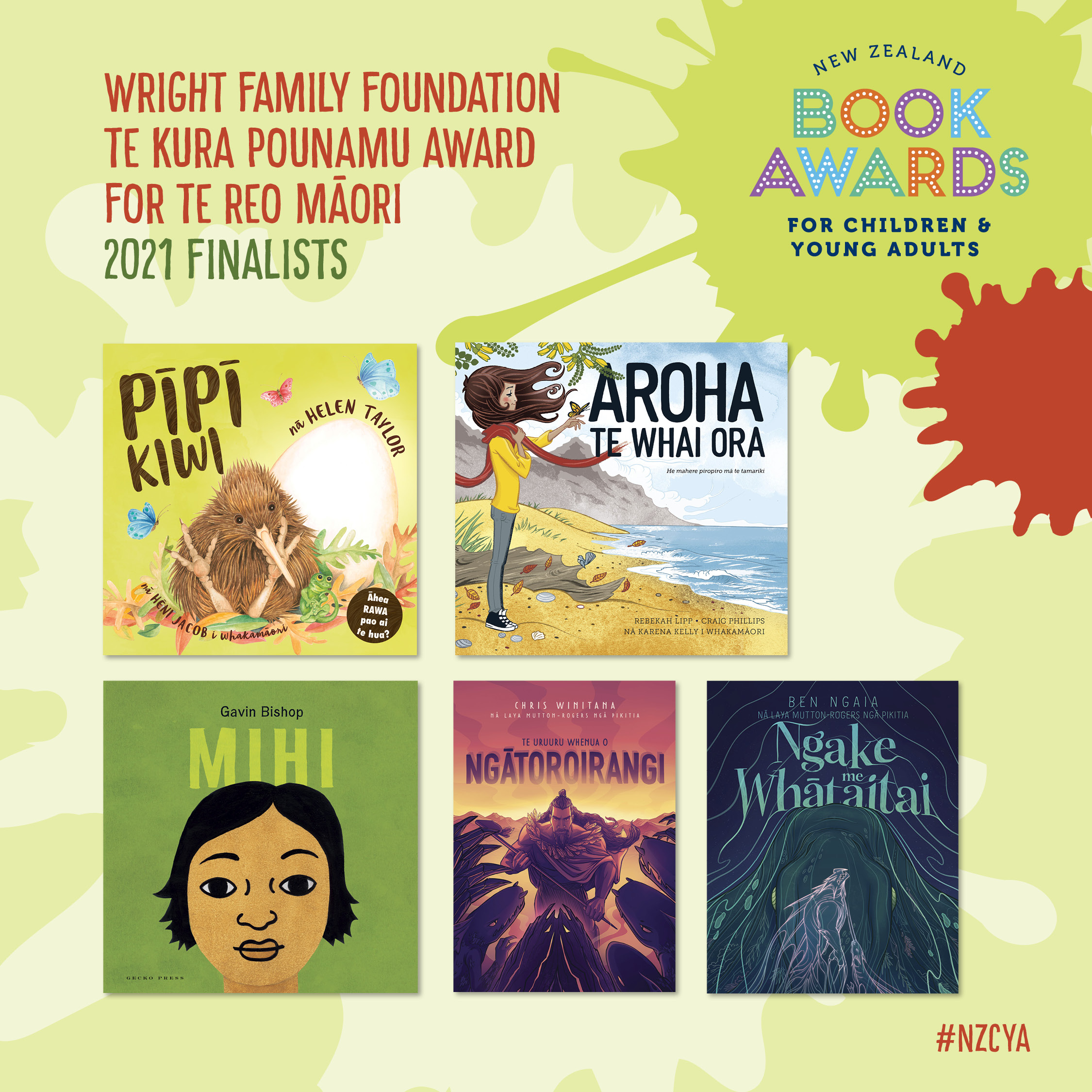
I’ll admit to not yet having sat and read through all of Te Uruuru Whenua o Ngātoroirangi as my pānui is a little slow and it’s very text heavy. I’m curious about precisely who is going to pick it up, as the text size and volume is definitely for an older reader, but they may be deterred by the picture book format. They shouldn’t be – sophisticated picture books are for everyone! – but I know kids can get a bit finnicky about books that look on the surface like they might be ‘too young’.
Both Te Uruuru Whenua o Ngātoroirangi and fellow finalist from Huia Publishers, Ngake me Whātaitai are illustrated by Laya Mutton-Rogers, who also illustrated last year’s Te Kura Pounamu winner Tio Tiamu. Ngake me Whātaitai is a story that residents of the capital might be familiar with – it’s the tale of the two taniwha of Te Whānganui-a-Tara. I love this book – not just because I’ve lived in Hataitai or the fact that I’ve done a Māori class presentation on the very same pūrakau.
Mihi is beautiful, should be an automatic addition to any baby book buying mission – but I do wonder whether it would be doing a disservice to the work of the writers (and in some cases translators) of the books that use reo Māori more extensively to give the award to a book that has such simple text? On the flip side though, it’s simple, effective, and perfectly formed. So never say never!
Aroha Te Whai Ora and Pīpī Kiwi have been translated by two of the best (Karena Kelly and Hēni Jacob respectively), but in this category I’m generally drawn a little more to the stories written in Māori from the outset. That being said, I’m also really delighted that both of these books are available for Māori-speaking households, as both are wonderful books that play important roles in development.
Pīpī Kiwi (the translation of Kiwi Baby) is an effective and terribly sweet story of a tuakana-to-be’s waiting for their little sibling to come along, and understanding that it will also take time for said sibling to be a fully fledged (pardon the bird pun) playmate.
Aroha Te Whai Ora (the translation of Aroha’s Way) was one of the leaders of the pack in the area of thoughtful and beautiful books from Aotearoa on children’s mental wellbeing. All kids across the motu should be able to take the guidance of books like Aroha Te Whai Ora, and I’m delighted that this can now be acquired in te reo Māori.
Text by Briar Lawry.
Our picks to win:
Briar: Ngake me Whātaitai by Ben Ngaia and Laya Mutton-Rogers
Simie: Ngake me Whātaitai by Ben Ngaia and Laya Mutton-Rogers
THE BEST FIRST BOOK AWARD FINALISTS
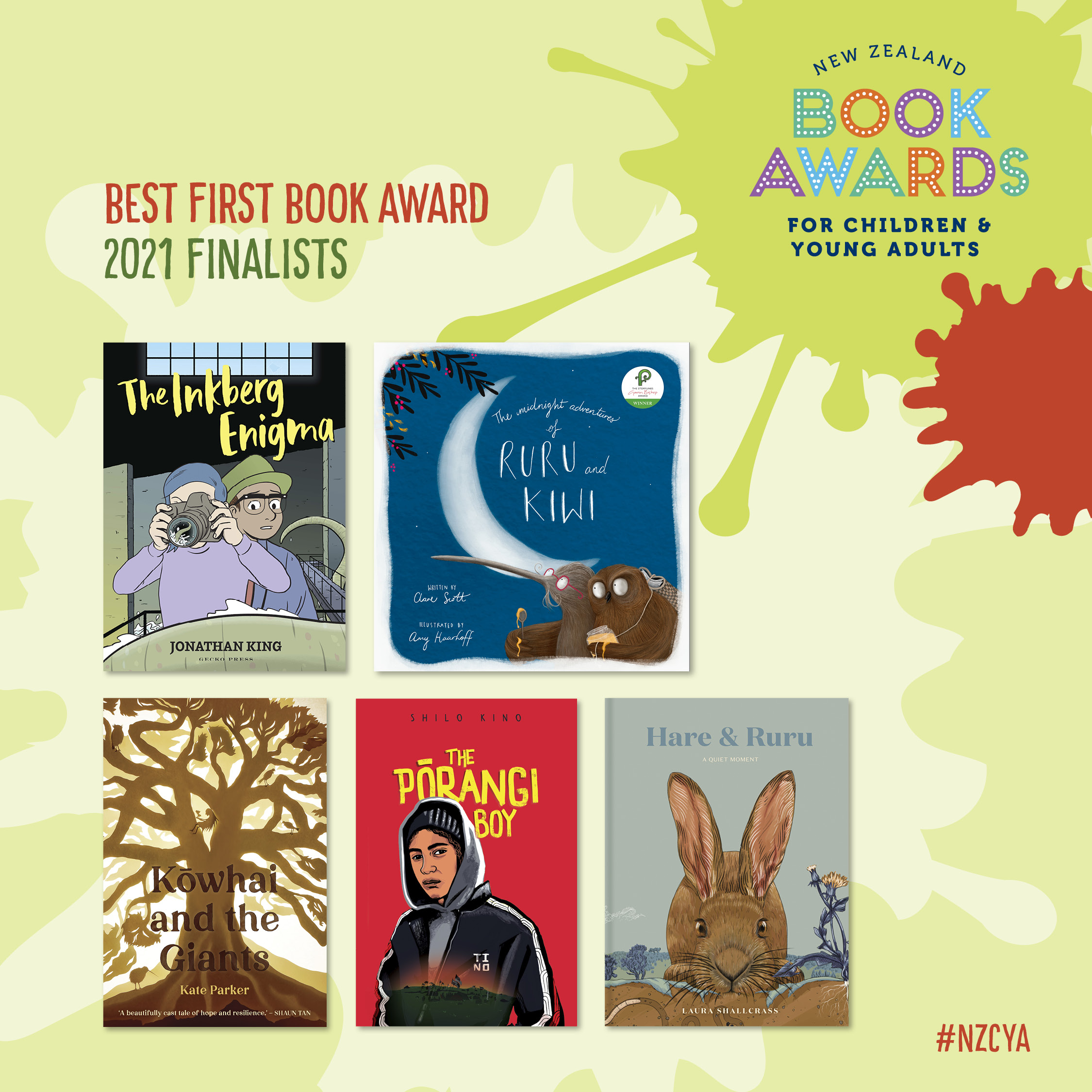
Hare & Ruru: a quiet moment, by Laura Shallcrass
This book is a wonderfully illustrated, beautifully elucidated explanation of overwhelm, for kids young and old. We see our hare seeking for quiet, while the world around them continues with its everyday noise. Finally he finds wise ruru, who gives him some advice: just breathe. The variation in illustration type is inspired, and I enjoyed seeing the way in which the splendour of the natural world carried on below the surface of the earth, with roots, worms, and tiny bones. Further commentary above.
The Inkberg Enigma, by Jonathan King
I don’t know how this can miss out on best first book. I enjoy all of the books in this category in different ways, but this is something special, as well as being rare in the New Zealand publishing industry, as a graphic novel. Further commentary above.
Kōwhai and the Giants, by Kate Parker
Ecology is another important topic to discuss, and I really love the way in which Kate has used light boxes to tell the story of Kōwhai, and how she gathered her friends to ensure the giants–her friends the Kāuri trees–live on. I agree with Shaun Tan, who is quoted on the front of the book. This is ‘a beautifully cast tale of hope and resilience.’ Further commentary above.
The midnight adventures of Ruru and Kiwi, by Clare Scott, illustrated by Amy HaarhogIt is Amy Haarhoff who is up for best first book in this category, and the judges certainly must have thought this was something quite remarkable, to put her forward independently. I happen to agree. I think that despite the dark palette, Amy has created an atmospheric and gorgeous artwork, with just enough light to raise our spirits.
The Pōrangi Boy, by Shilo Kino
Shilo Kino explores a slice of life in the world of a whānau who are fighting for their land. With well drawn characters, and a beautiful soul at the centre of the book, it certainly deserves its nomination. Further commentary above.
Text by Sarah Forster
Our picks to win:
Briar: The Inkberg Enigma, by Jonathan King
Nida: The Inkberg Enigma, by Jonathan King
Sarah: The Inkberg Enigma, by Jonathan King
Simie: The Pōrangi Boy by Shilo Kino







